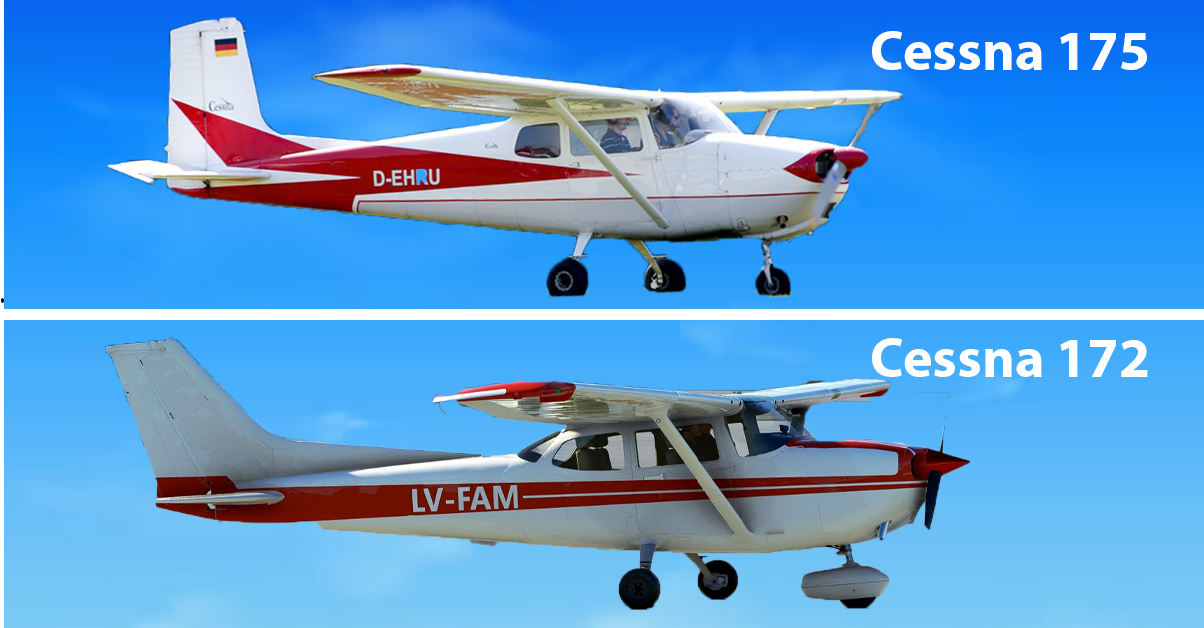Cessna 175 vs 172: A Tale of Two Skies” – The world of light aircraft is indeed a realm of fascination, offering a myriad of choices for pilots and aviation aficionados. In this vibrant landscape, two models stand prominently: the Cessna 175 and Cessna 172, each renowned for their distinct blend of reliability and performance. This blog post is dedicated to drawing a comprehensive comparison between these two celebrated aircraft, delving into their similarities and differences. Our aim is to provide you with a clear understanding of how each model fares against the other, helping you determine which aircraft might best suit your flying aspirations and needs.
Cessna 175 vs 172

Cessna 175 vs 172: Pioneers of the Sky” – The Cessna 175 and Cessna 172 are quintessential models in the world of general aviation, each with its own unique appeal to pilots and aviation enthusiasts. Born in the late 1950s, these members of the Cessna aircraft family epitomize a harmonious mix of dependability and performance. The Cessna 172, widely acclaimed for its user-friendliness, has become a staple in flight training schools globally. In contrast, the Cessna 175 is distinguished by its more robust engine, appealing to those in pursuit of greater performance. This comparative analysis aims to explore the subtle yet significant distinctions that set apart these two iconic aircraft.
| Feature | Cessna 172 | Cessna 175 |
|---|---|---|
| First Introduced | 1956 | 1958 |
| Engine | Lycoming O-320 series | Continental GO-300 |
| Horsepower | 145 – 160 HP | 175 HP |
| Cruising Speed | 122 knots | 130 knots |
| Range | 696 nautical miles | Similar to Cessna 172 |
| Production Years | 1956-present | 1958-1962 |
| Payload Capacity | Good for its class | Slightly higher |
| Maintenance | Relatively easy and cost-effective | complex due to geared engine |
Cessna 175
The Cessna 175, introduced in 1958, was a distinctive addition to the Cessna aircraft line, positioned to fill the gap between the Cessna 172 and the faster Cessna 182. Its most notable feature was the use of a geared Continental GO-300 engine, which provided about 175 horsepower, granting it superior performance in certain aspects compared to its sibling, the Cessna 172.

The Cessna 175 was marketed under different names, including the ‘Skylark’. Although its production run was relatively short, lasting until 1962, the 175 left a lasting impact in the general aviation community. It catered to pilots seeking a blend of manageable handling akin to the 172, but with a bit more power and altitude capability, often appealing to more experienced flyers or those with specific flight mission requirements.
Cessna 172
The Cessna 172, first introduced in 1956, is arguably the most iconic light aircraft in aviation history. Known for its unparalleled record as the most produced aircraft, the 172 has been a staple in flight training and private aviation for decades. Its enduring popularity stems from its reliable performance, easy handling, and versatility. Equipped with a Lycoming O-320 series engine in most models, providing between 145 to 160 horsepower, the 172 offers a balance of efficiency and performance that is ideal for both novice and experienced pilots.

The aircraft’s simple design, forgiving flight characteristics, and cost-effective maintenance have made it a top choice for flight schools and private owners around the world. Its continuous production and evolution, with models like the 172R and 172SP, demonstrate its ongoing relevance and adaptability in the ever-changing world of aviation.
Design and Comfort
Cessna 175
The Cessna 175’s cabin is designed with a focus on functionality without compromising comfort. It comfortably seats up to four passengers, with each seat providing adequate space for relaxed seating, especially important for longer flights. The cockpit in the 175 is straightforward and user-friendly. Its layout is efficient, with all necessary controls and instruments within easy reach, ensuring a comfortable flying experience for the pilot.
Cessna 172
Conversely, the Cessna 172 features a cabin that skillfully balances classic aesthetics with functional design. Its interior is more than just a training space; it’s also crafted for comfort on personal flights. The 172’s seating accommodates four passengers and is designed for both comfort and durability, an essential aspect considering its frequent use in training. The cockpit is intuitive and well-organized, making it an ideal learning environment for student pilots while also being comfortable for experienced flyers.
Performance, Capacity, and Range
The Cessna 175 stands out with its Continental GO-300 engine, offering enhanced performance compared to its counterpart. This model boasts a higher cruising speed, making it suitable for pilots looking for a bit more punch in their flights. Additionally, it has a longer range, capable of covering extended regional distances comfortably. This feature positions the 175 as a favorable choice for those requiring additional power and extended flight capabilities.
The Cessna 172, equipped with the reliable Lycoming O-320 engine, is tailored for efficiency and ease. It is particularly well-suited for short to medium-range flights, a feature that has cemented its status as the go-to trainer aircraft. The balanced performance of the 172 ensures adaptability across various flight conditions, making it a versatile choice for both training and personal use.
Tech and Efficiency
The Cessna 175’s geared engine is a notable aspect of its design but comes with the need for specialized maintenance. While it delivers improved performance, it also leads to higher fuel consumption and potential complexities in maintenance, which are important considerations for owners.
In contrast, the Cessna 172’s engine is celebrated for its durability and minimal maintenance demands. This efficiency, combined with its effective fuel consumption, makes the 172 a cost-effective option, particularly for flight training and personal flying, helping to keep operational costs down.
Airline Economics and Operations
Operating the Cessna 175 tends to be costlier due to its increased fuel usage and maintenance requirements. It’s not commonly seen in commercial operations but has carved a niche among specialized aviation sectors and enthusiasts who appreciate its unique characteristics.
The Cessna 172, on the other hand, is a staple in flight schools and small commercial operations due to its economical operation. Its combination of reliability and low operating costs make it an attractive platform for training and operational purposes.
Role in Modern Airline Fleets
Though not as widely used as the 172, the Cessna 175 holds a special spot in the hearts of aviation enthusiasts and collectors. Its distinctive engine and performance traits make it appealing to a specific segment of the aviation market.
The Cessna 172 plays a crucial role in contemporary aviation. It’s foundational in numerous training programs globally and is equally popular among private owners for its mix of versatility and dependability.
Pros and Cons
Cessna 175
- Pros: Higher performance suitable for diverse flying conditions.
- Cons: Requires more maintenance, less fuel-efficient, and less common in the market.
Cessna 172
- Pros: Broadly available and supported, cost-effective in operation and maintenance, ideal for training and beginner pilots, versatile for various flight missions.
- Cons: Less powerful compared to the 175, not as suited for high-altitude or demanding flights.
Cessna 175 vs 172 Pricing
In terms of pricing, the Cessna 175 and Cessna 172 present a wide range that reflects their age, condition, and usage history. The Cessna 175, a rarer model due to its limited production run, is typically priced around $79,000. This cost can vary depending on the aircraft’s condition and any upgrades it may have undergone.
On the other hand, the Cessna 172, known for its popularity and wide availability, offers a broader price spectrum. For an older model with high flight hours, prices start around $40,000, making it an accessible option for those entering the world of aviation ownership. However, for late-model 172s that have been gently used and possibly come with more advanced avionics or other upgrades, the price can soar up to $300,000. This wide price range in the Cessna 172 reflects its versatility and the varying levels of modernization and condition found in the market.
This pricing comparison underscores the Cessna 172’s flexibility in catering to a broad spectrum of buyers, from budget-conscious individuals to those seeking a more modern and equipped aircraft, while the Cessna 175 remains a more niche choice with a relatively fixed price point.
Conclusion
The choice between the Cessna 175 Vs 172 largely depends on individual preferences and requirements. The Cessna 172, with its extensive history and reputation as a reliable trainer, is a more practical choice for most pilots. The Cessna 175, with its more powerful engine, appeals to those looking for a bit more performance. Ultimately, both aircraft represent the enduring legacy of Cessna’s commitment to quality and reliability in the world of aviation.
FAQs
Is the Cessna 175 better than the Cessna 172?
Can a beginner pilot fly a Cessna 175 or 172?
Which aircraft is more cost-effective to operate?
Can these aircraft be used for cross-country flights?
Are parts readily available for both aircraft?



